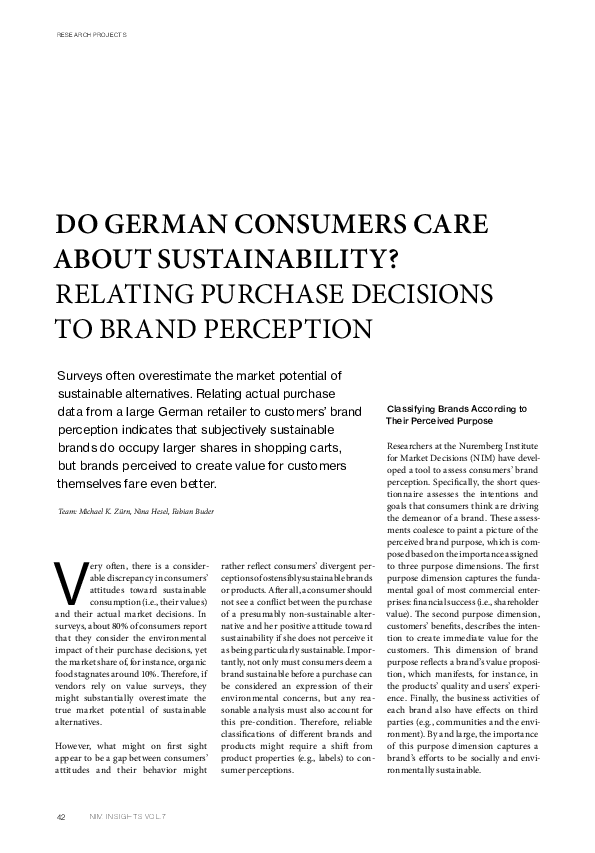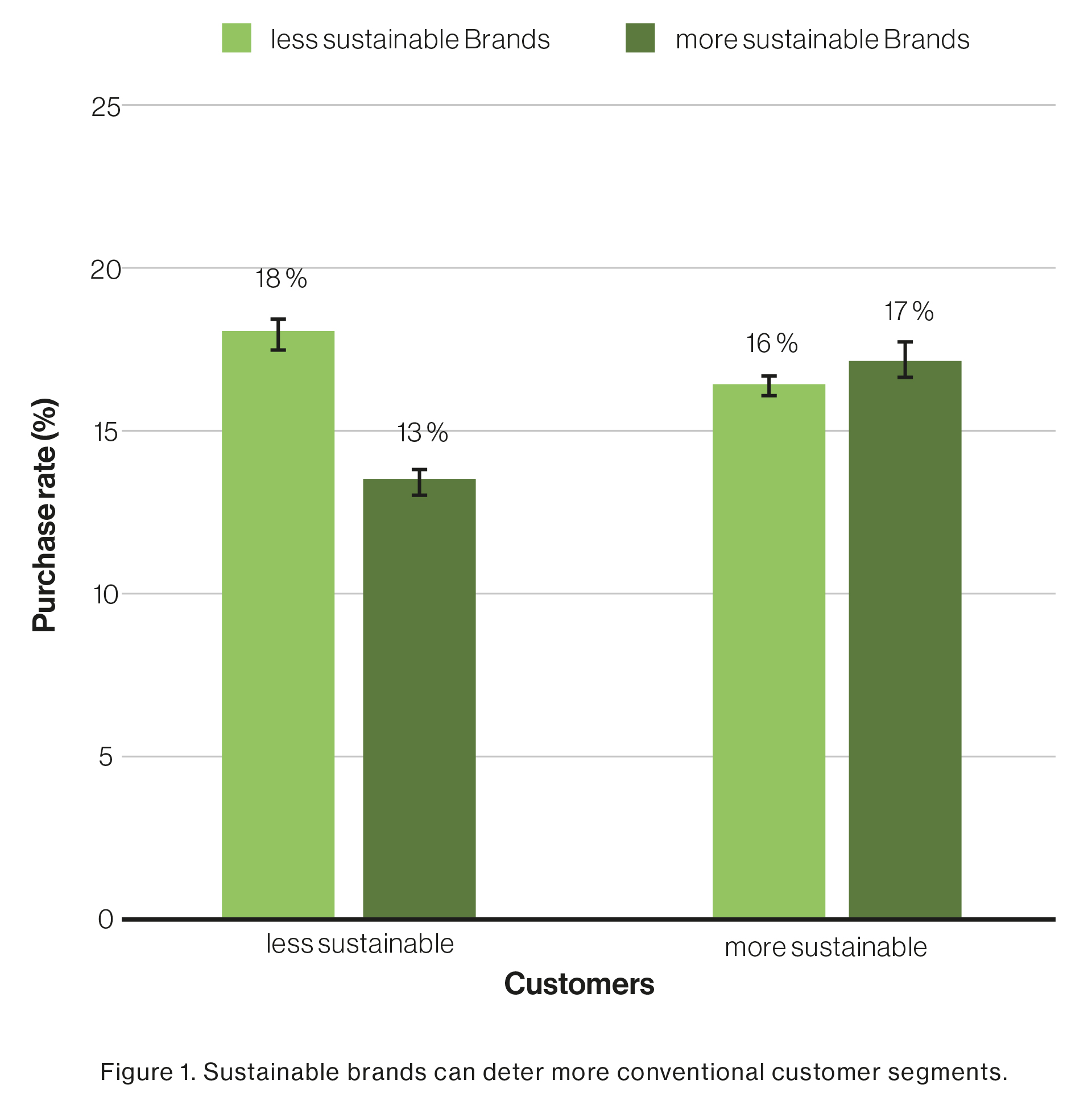Research
Do German Consumers Care About Sustainability?
Surveys often overestimate the market potential of sustainable alternatives. Relating actual purchase data from a large German retailer to customers’ brand perception indicates that subjectively sustainable brands do occupy larger shares in shopping carts, but brands perceived to create value for customers themselves fare even better.
Very often, there is a considerable discrepancy in consumers’ attitudes toward sustainable consumption (i.e., their values) and their actual market decisions. In surveys, about 80% of consumers report that they consider the environmental impact of their purchase decisions, yet the market share of, for instance, organic food stagnates around 10%. Therefore, if vendors rely on value surveys, they might substantially overestimate the true market potential of sustainable alternatives.
However, what might on first sight appear to be a gap between consumers’ attitudes and their behavior might rather reflect consumers’ divergent perceptions of ostensibly sustainable brands or products. After all, a consumer should not see a conflict between the purchase of a presumably non-sustainable alternative and her positive attitude toward sustainability if she does not perceive it as being particularly sustainable. Importantly, not only must consumers deem a brand sustainable before a purchase can be considered an expression of their environmental concerns, but any reasonable analysis must also account for this pre-condition. Therefore, reliable classifications of different brands and products might require a shift from product properties (e.g., labels) to consumer perceptions.
Classifying Brands According to Their Perceived Purpose
Researchers at the Nuremberg Institute for Market Decisions (NIM) have developed a tool to assess consumers’ brand perception. Specifically, the short questionnaire assesses the intentions and goals that consumers think are driving the demeanor of a brand. These assessments coalesce to paint a picture of the perceived brand purpose, which is composed based on the importance assigned to three purpose dimensions. The first purpose dimension captures the fundamental goal of most commercial enterprises: financial success (i.e., shareholder value). The second purpose dimension, customers’ benefits, describes the intention to create immediate value for the customers. This dimension of brand purpose reflects a brand’s value proposition, which manifests, for instance, in the products’ quality and users’ experience. Finally, the business activities of each brand also have effects on third parties (e.g., communities and the environment). By and large, the importance of this purpose dimension captures a brand’s efforts to be socially and environmentally sustainable. In sum, this approach does not assess sustainability as an isolated aspect but embeds this important issue in a more comprehensive perception of a brand. Crucially, the importance brands ascribe to these purpose dimensions is judged by consumers. Therefore, the scores of different brands on the thirdparty effects dimension might be a novel, reliable way to classify brands in terms of their perceived sustainability. Based on such a classification, it is then possible to gauge the actual gap between consumers’ attitudes and their purchase decisions.
Sustainability Is Good—Good Products Are Better
In collaboration with a large German retailer, NIM researchers conducted a study to analyze the purchase decisions of more than a thousand customers across 84 different brands. Customers were invited to complete a survey to assess their subjective brand perceptions using the tool described above. Afterward, individual brand perceptions were matched with individual purchase data for the rated brands. The survey additionally included established measures to assess consumers’ attitudes toward sustainable consumption.
The results show that overall, the more sustainability oriented a customer perceives a brand to be, the higher the brand’s share is in that customer’s individual shopping cart. However, the relationship between a brand’s perceived focus on customer benefits and its share in shopping carts is even stronger. Put differently, while consumers in general seem to purchase more products from brands they consider sustainable, they purchase even more from brands they consider to be more interested in benefitting customers.
Sustainability Can Act as a Deterrent
But do consumers who are particularly concerned about the social and environmental impact of their purchase decisions show a stronger demand for brands they perceive as sustainable? The findings tentatively suggest an affirmative answer to this question. While consumers with a less positive attitude toward sustainability do not purchase more products from brands they perceive as sustainable, consumers with a more positive attitude toward sustainability do reserve a larger share of their shopping carts for brands they consider sustainable. This might indicate that consumers do indeed act in line with their values.
However, a different analysis incorporating more data paints a more nuanced picture. Classifying brands according to their perceived sustainability and consumers according to their sustainability attitude allows for a comparison of purchase probabilities among the four resulting groups (see Figure 1). This analysis suggests that high perceived sustainability of a brand might be an exclusion criterion for customers with a less pronounced sustainability preference—that is, while customers with a more pronounced sustainability preference are slightly more likely to purchase products from brands they perceive as sustainable, customers less concerned with sustainability are a lot less likely to purchase products from sustainable brands (13%) than conventional brands (18%). Therefore, the consistency between attitudes and behavior seems to manifest in decreased sales of sustainable brands in less sustainability-oriented customer segments.
KEY INSIGHTS
- To differentiate sustainable and conventional brands, consumer perceptions must be taken into account.
- Brand perception can be easily and reliably measured with an openly available tool.
- Brands focusing on sustainability occupy larger shares in customers’ shopping carts, but brands focusing on customer benefits perform even better.
- Customers do purchase according to their values, but a focus on sustainability can be a deterrent for less “green” customer segments.
Project team
- Dr. Michael K. Zürn, Senior Researcher, NIM, michael.zuern@nim.org
- Nina Hesel, Senior Researcher, NIM, nina.hesel@nim.org
- Dr. Fabian Buder, Head of Future & Trends Research, NIM, fabian.buder@nim.org
Contact


